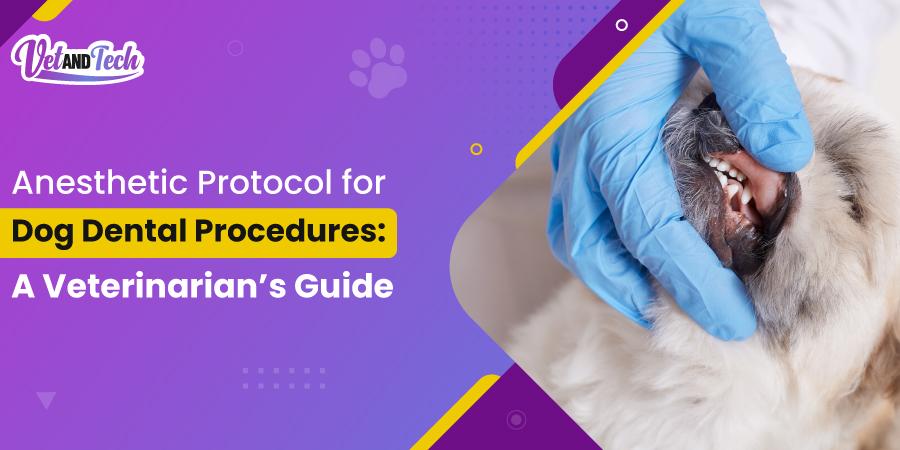Anesthetic Protocols for Dog Dental Procedures - A Veterinarian’s Guide
Veterinary care is incomplete without dental treatments, as proper periodontal procedures play a crucial role in maintaining a dog's oral health and preventing dental diseases. Dental procedures are impossible to execute safely without following the anesthetic protocols for dog dental.
An anesthetic protocols minimizes the risk of pain during the surgery and also improves the outcomes. In this blog post, we’ll take a look at the following points;
- What is an anesthetic protocols for dog dental procedures?
- Why are these protocols necessary?
- What is canine anesthesia for dental procedures?
- Key components of canine anesthesia for dog dental
An Overview of Anesthetic Protocols
An anesthetic protocols is a set of rules for administering and managing sedation during dog dental surgery. From the pre-anesthetic examination to post-operative care, an anesthetic protocols involves all the steps!
Vet specialists must follow anesthetic protocols to ensure safe and atraumatic dental procedures. However, the number/type of dog anesthesia protocols for dog dental is specified according to the complexity of each dog's dental treatment.
By following the proper rules, veterinarians can avoid the complexities such as hypotension, hypoxia, and adverse drug reactions in dogs.
Importance of Anesthetic Protocols for Dog Dentals
A measured anesthetic protocols is essential for dog dental operations. Whether it is simple tooth extraction or any other periodontal surgery, anesthesia ensures the atraumatic procedure. Here are a few points to highlight the importance of anesthesia protocols in dog dentistry;
- With the proper anesthetic protocols, veterinarians can ensure safety and reduce the risks of post-anesthesia reactions.
- By following the anesthesia protocols correctly, veterinarians ensure pain-free patient recovery with analgesia after a dental procedure or surgery.
- Vet specialists can perform the procedure efficiently without discomforting and stressing the dogs with the right amount of anesthesia during surgery.
- A skilled veterinarian adjusts the anesthesia plan based on the dog's health, age, and the procedure's complexity.
- Anesthetic protocols ensure the efficiency of periodontal procedures by reducing the chances of dog movements. They also offer a smooth workflow to veterinarians and their teams.
Anesthesia is essential for most dog dental procedures, including tooth extraction, surgery, and dental prophylaxis. Even a calm and friendly dog cannot stay still during these procedures, so general anesthesia ensures immobilization and pain management.
Key Components of Canine Anesthetic Protocols
Here are the components of canine anesthetic protocols for a dog’s periodontal procedures a vet should follow;
- Pre-anesthetic assessment
- Pre-anesthetic preparation
- Pre & post-maintenance
- Dog Anesthesia Monitoring
- post-operative care
1: Pre-Anesthetic Assessment
A proper and complete examination is necessary before anesthetizing the dog for a dental procedure. Identifying the risk factors and specifying the quantity of anesthesia accordingly is crucial. For pre-anesthetic assessment, veterinarians consider the following steps;
- History Check and Physical Exam
A veterinarian assesses the dog's health and history, as well as its current medications and diseases. Then, through a complete blood count (CBC), a professional panel detects any underlying conditions in the dog, such as liver or kidney diseases.
- Pre-Anesthetic Stabilization
In this step, veterinarians address any existing medical condition and try to treat it accordingly. For instance, vet doctors treat dehydration in dogs with fluid therapy before following the anesthesia protocols.
2: Pre-Anesthetic Preparation
In pre-anesthetic preparation, veterinarians mainly provide the pet owners/parents with guidelines including;
- Fasting Guidelines
Most vet specialists recommend 8-12 hours of fasting for adult dogs before anesthesia. Fasting will reduce the risk of aspiration. On the other hand, moderate fasting is required for critical and pediatric vet patients.
- Pre-Anesthetic Medication
These drugs reduce stress and also provide pain relief. The most common pre-anesthetic drugs include sedatives, Opioids, and Anticholinergics.
3: Pre & Post-Maintenance
Before putting dogs under anesthesia, a veterinarian injects an induction agent such as Propofol, Alfaxalon, and Ketamine-Diazepam. These agents offer rapid control over the animal before the surgery.
In addition to induction agents, the standard maintenance anesthesias for dogs are inhalants and CRI (Confusion Rate Infusion). Additionally, Bupivacaine or Lidocaine are the most commonly used local anesthetists in veterinary dentistry.
4: Anesthesia Monitoring
Even during periodontal surgery, continuous anesthesia monitoring is needed. It is necessary to perform the surgery safely and reduce the pain factor.
The key parameters of anesthesia monitoring include;
- ECG
During the procedure, ECG detects the heart rate, rhythm, and cardiac instability.
- Blood Pressure
It is about monitoring hypotension and adjusting fluid therapy to maintain blood pressure and hydration levels.
- Oxygenation and Ventilation
It involves continuously measuring oxygen saturation to prevent hypoxia and tracking the CO2 level to assess the ventilation status.
- Temperature Regulation
It is all about preventing hypothermia with warming devices such as heated blankets or warm IV fluids.
- Anesthesia Depth
It assesses jaw tone, palpebral reflexes, and cardiovascular stability during anesthetizing.
5: Post-Procedure Care
Post-anesthesia care is essential for fast recovery and reduction of pain. Most vet doctors provide analgesics, such as Caprofen and Meoxicam, for post-operative pain management.
Additionally, Opioids such as Hydromorphone and Tramadol can be used to treat moderate to severe pain. Post-operative monitoring is also needed for observing the signs of hypothermia, dysphoria, and respiratory distress.
A professional vet doctor is responsible for offering the pet's parents a complete list of discharge instructions. So they can perform the feeding and medication activities accordingly to reduce the signs of post-operative complications. Read this blog to learn more about dentistry procedures in exam room.
Final Words
In conclusion, anesthesia protocol for dogs dental is key to ensuring a safe, effective, atraumatic dog dental procedure. By following the proper pre and post-operative steps, veterinarians can reduce the risks, manage pain, and help canine patients for quick recovery.
Ready to Block Pain? Earn 1 CE Credit with Dr. Jennifer R. Mathis's Dental 'Block Party'!
Join the fun with Dr. Jennifer R. Mathis as she guides you through effective local anesthesia techniques for happier dental patients!
Advance your veterinary skills by attending the Local Block Party Webinar with Jennifer Mathis, DVM. Whether you're a seasoned professional or a student, this session will provide insights you can apply in your practice.
- Free virtual learning opportunity
- Earn 1 CE Credit from an accredited provider
- Gain knowledge from a leading industry expert
So, register now to watch for free: Join the Local Block Party
Frequently Asked Questions
How long are dogs under anesthesia for dental procedures?
A dog may remain under anesthesia for any treatment for approximately 45 minutes to 8 hours, depending on the complexity of the procedure.
Is it safe for dogs to go under anesthesia for teeth cleaning?
When specialists do the dog's dental cleaning, it is entirely safe for dogs to go under anesthesia.
What are the risks of anesthesia in dogs?
Anesthesia in dogs also leads to a few risk factors, such as organ failure, allergic reaction, nerve damage, cardiac arrest, and muscle damage.
Why should vets use local anesthetics in veterinary dentistry?
Local anesthetics in veterinary dentistry allows pain relief, minimizes discomfort, and ensures a smooth workflow during the procedure.









